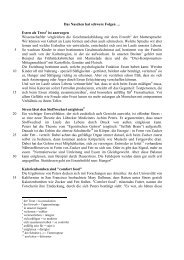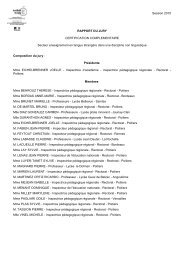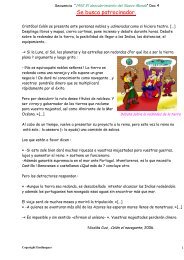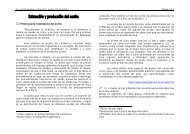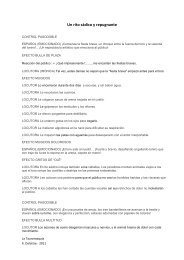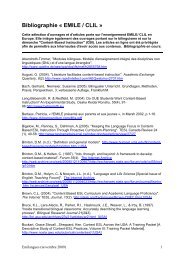SCRIPT PLATONIC SOLID ROCK Source : http://www.youtube.com ...
SCRIPT PLATONIC SOLID ROCK Source : http://www.youtube.com ...
SCRIPT PLATONIC SOLID ROCK Source : http://www.youtube.com ...
You also want an ePaper? Increase the reach of your titles
YUMPU automatically turns print PDFs into web optimized ePapers that Google loves.
<strong>SCRIPT</strong><br />
<strong>PLATONIC</strong> <strong>SOLID</strong> <strong>ROCK</strong><br />
<strong>Source</strong> : <strong>http</strong>://<strong>www</strong>.<strong>youtube</strong>.<strong>com</strong>/watch?v=Ye24b3ebHcw<br />
Part 1: Prove that there exists only 5 Platonic solids.<br />
00:00<br />
A stranger came upon an ancient ruin and in its stone were carved the following words:<br />
If it is the wisdom of the Platonic solids you seek then through the pentagonal cave you must pass.<br />
The stranger headed to the cave.<br />
The armored ? cave was extraordinary new dimension unlike anything the stranger had ever<br />
experienced.<br />
A disembodied voice began in a rythm enchant, it seemed foreign yet oddly familiar.<br />
Wel<strong>com</strong>e stranger, you have entered the round of the Platonic solid.<br />
I'll show you some worthy of its wisdom.<br />
May it serve you well.<br />
01:09<br />
A fantastic motif dimensional vision emerged.<br />
The first most basic shape is the point.<br />
No dimension says the point, no length, no width, no height.<br />
Two points connected make the second simplest shape, a line.<br />
Just one dimension has the line, length.<br />
Three lines make the simplest two dimensional shape, the equilateral triangle.<br />
Equilateral means all the sides are equal.<br />
The equilateral triangle exists in two dimensions, height and width, no depth.<br />
It takes four equilateral triangles to make the simplest three dimensional shape.<br />
Lay three equilateral triangles together on the plane point to point.<br />
Allow the bodies to rise up out of the plane until their outer edges meet.<br />
Place the fourth equilateral triangle on the top.<br />
The tetrahedron is formed,<br />
tetra means four, hedron means faces.<br />
The tetrahedron has three dimensions, height, width and depth.<br />
02:17<br />
The tetrahedron is the first of the Platonic solids.<br />
A Platonic solid must have the same regular polygons for each of its faces and the same number of<br />
faces meeting together at each corner.<br />
A regular polygon must be a two dimensional shape with all sides of equal length<br />
and all the corners have the same angle.<br />
Some examples of regular polygons are the equilateral triangle, the square, the pentagon, the<br />
hexagon.
02:43<br />
Lay four equilateral triangles together on the plane point to point.<br />
Allow the bodies to rise up out of the plane until their outer edges meet.<br />
Repeat the process, lay one set on top of the other.<br />
The octahedron is formed,<br />
octa means eight, hedron means faces.<br />
03:05<br />
Lay five equilateral triangles together on the plane point to point.<br />
Allow the bodies to rise up out of the plane until their outer edges meet.<br />
Place five more equilateral triangles around the rim.<br />
Repeat the process, lay one set on top of the other.<br />
The icosahedron is formed,<br />
icosa means twenty, hedron means faces.<br />
03:31<br />
Lay six equilateral triangles together on the plane point to point.<br />
Their bodies have no room to rise up out of the plane.<br />
They cannot enter the third dimension.<br />
No more Platonic solid can be formed with equilateral triangles.<br />
03:49<br />
Lay three squares together on the plane point to point.<br />
Allow their bodies to rise up out of the plane until their outer edges meet.<br />
Repeat the process, lay one set on top of the other.<br />
The cube is formed,<br />
the cube is also known as the hexahedron,<br />
hexa means six, hedron means faces.<br />
04:10<br />
Lay four squares together on the plane point to point.<br />
Their bodies have no room to rise up out of the plane.<br />
They cannot enter the third dimension.<br />
No more Platonic solid can be formed with squares.<br />
04:25<br />
Lay three pentagons together on the plane point to point.<br />
Allow their bodies to rise up out of the plane until their outer edges meet.<br />
Place three more pentagons around the rim.<br />
Repeat the process, lay one set on top of the other.<br />
The dodecahedron is formed,<br />
dodeca means twelve hedron means faces.<br />
It is impossible to lay 4 pentagons together on the plane point to point.<br />
No more Platonic solid can be formed with pentagons<br />
05:00<br />
Lay three hexagons together on the plane point to point.<br />
Their bodies have no room to rise up out of the plane.<br />
They cannot enter the third dimension.<br />
No Platonic solid can be formed with hexagons.
It is impossible to lay three heptagons together on the plane point to point.<br />
No Platonic solid can be formed with heptagons.<br />
You have now seen all five Platonic solids,<br />
the tetrahedron, the octahedron, the icosahedron, the cube or hexahedron and the dodecahedron.<br />
No other three dimensional shapes exist having the same number of identical regular polygon faces<br />
meeting at each corner.<br />
Part 2: dual pairs.<br />
05:45<br />
Take a cube, connect the centers of its faces. A small octahedron is formed inside the cube. Let the<br />
octahedron grow, a star shaped structure is formed. This is the stellated polyhedrons. Stellar means<br />
star. Eventually the octahedron <strong>com</strong>pletely encloses the cube.<br />
Take an octahedron, connect the centers of its faces. A small cube is formed inside the octahedron.<br />
Let the cube grow, the same stellated polyhedron is formed. Eventually the cube <strong>com</strong>pletely<br />
encloses the octahedron.<br />
Because of this relationship between the cube and the octahedron, they're known as a dual pair.<br />
Take a dodecahedron, connect the centers of its faces. A small icosahedron is formed inside the<br />
dodecahedron. Let the icosahedron grow, a stellated polyhedron is formed. Eventually the<br />
icosahedron <strong>com</strong>pletely encloses the dodecahedron.<br />
Take an icosahedron, connect the centers of its faces. A small dodecahedron is formed inside the<br />
icosahedron. Let the dodecahedron grow, the same stellated polyhedron is formed. Eventually the<br />
dodecahedron <strong>com</strong>pletely encloses the icosahedron.<br />
The dodecahedron and the icosahedron form a dual pair.<br />
Take a tetrahedron, connect the centers of its faces. A second smaller tetrahedron is formed inside<br />
the original tetrahedron. Let the new tetrahedron grow, a stellated polyhedron is formed. Eventually<br />
the second tetrahedron <strong>com</strong>pletely encloses the first tetrahedron.<br />
A tetrahedron forms a dual pair with itself.<br />
You have seen that the five Platonic solids can be divided into three dual pairs: the cube and the<br />
octahedron, the dodecahedron and the icosahedron, and a tetrahedron and itself.<br />
At each corner of the cube three faces meet, each having four sides.<br />
At each corner of the octahedron four faces meet, each having three sides.<br />
At each corner of the dodecahedron three faces meet, each having five sides.<br />
At each corner of the icosahedron five faces meet, each having three sides.<br />
At each corner of the tetrahedron three faces meet, each having three sides.<br />
Now that you have gained the wisdom of the Platonic solids you must take leave of this round. May<br />
it serve you well.<br />
The stranger passed back through the pentagonal cave to the world beyond, who was the same<br />
world as before, but in the stranger's eyes would never look the same again.



